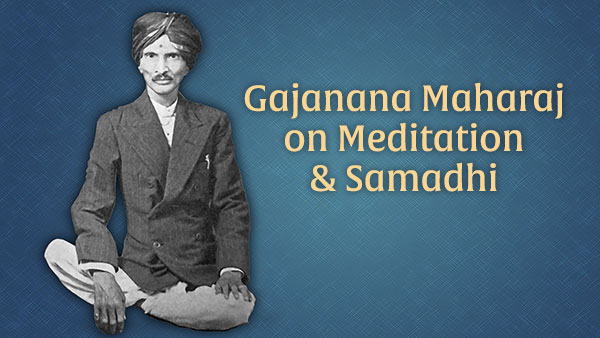Wisdom of Sri Gajanana Maharaj of Nashik
The difference between meditation and concentration
Some persons do not understand the difference between meditation (dhyana), and concentration (ekagrata). Suppose a person sits and repeats the Soham mantra mentally. A few minutes later someone asks him, “How did you feel? Had you any thoughts? Was the flow of thoughts going on as usual, or was there any difference? How was the japa going on?”
When such questions are asked the aspirant appears to be a little confused, and is usually found to answer in the following manner: “My mind was quite calm. Not a single idea arose in my mind. The japa was going on in an undisturbed manner. I was enjoying peace. But my mind was not concentrated. I could hear the sounds and movements taking place about me.”
It is a common idea with ordinary aspirants that as soon as they begin meditation of the mantra Soham their mind should become concentrated and they should enter into the state of samadhi. It is a laudable wish, no doubt, but it is out of place at the time. Because when the person begins to meditate upon Soham, he does not need to get concentrated at once.
He is repeating the japa of Soham in so he may be able to meditate properly. The main idea in meditation is that while the japa is going on there should not be the flow of other thoughts disturbing the repetition of the mantra. Our mind is naturally fickle. It is very difficult for it to concentrate itself upon one idea.
In the case of some aspirants, however, owing to some practice done in the previous life they get concentrated as soon as they begin meditation. They may also see some visions. But this only shows that they must have practiced to some extent in their previous life. They therefore get all those experiences almost at once. But this does not mean that they have, owing to this, got everything which is to be obtained from the practice. They must not stop there, but carry on further practice until they reach the final goal of human life.
“All possible troubles beset the worldly life.” Keeping this truth firmly in mind, it is necessary to get deliverance from samsara (worldly existence) by the internal repetition of Soham. The seeing of many visions is not a sure sign of progress. Real progress lies in the continuous meditation on the sound of Soham going on without a break after the visions have stopped.
If a person carries on the continuous practice of the Soham japa, his mind will in course of time get concentrated upon it, and he will then experience the state of samadhi. In this stage, the sound of Soham is going on even more intensely than before.
Attaining the state of samadhi is not the final goal of our life
In the state of samadhi there is no consciousness of the external world, and there is experience of bliss. But this state lasts only for a short time. As soon as the normal consciousness is gained, the world makes its presence felt as before and the old play of desires, full of pleasure and pain, commences. Thus it will be seen that it is a mistake to suppose that we have reached our final goal when we reach the state of samadhi.
What is necessary in this stage, is that even while we are conscious of worldly objects our meditation on Soham must be ceaselessly going on, and the worldly objects and events should produce no reaction on our mind, making it unsteady.
Hence it is necessary to carry on the meditation of Soham ceaselessly. When this practice is carried on continuously, a state is reached when the presence of the Paramatman is felt in all the three states: the waking, the dreaming and the sleeping. When this is reached we experience the state of samadhi even while we are doing worldly activities. The mind itself becomes one with Soham and the truth of the following words is realized: “The mind has become fixed and motionless in one place. Atmic bliss has, therefore, been realized to the full. Nothing remains lacking.”
Aspirants should be become despondent and abandon the practice through a sense of frustration if they find that their efforts are not crowned with success in a short time. They are sure to realize the real power of Soham after some days if they carry on the practice continuously, with great intensity. There is absolutely no doubt about this. I say this from my own experience. The aspirant should have the firm determination that he will carry on the practice of Soham intensely in the future, although he might have failed to do so in the past.
For unknown words, see A Brief Sanskrit Glossary on our website.
NOTE: Atmaprabha, from which this blogpost is taken can be found in Appendix One of our publication Soham Yoga. Other teachings of Sri Gajanana Maharaj can be found in Chapter Three of Soham Yoga.
You can also read Soham Yoga on our website here.








